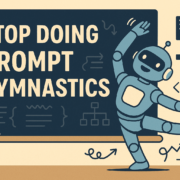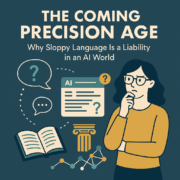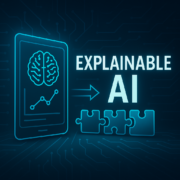Does AI Tell the Truth? What I’ve Learned About Accuracy, Hallucinations, and Getting the Right Output
One of the first questions I asked when I started working with AI was simple:
Can it tell the truth?
Not just facts—but reliable, consistent, useful truth.
What I learned over time is more nuanced than I expected.
The answer isn’t a yes or no.
It’s closer to: “It depends—on how you ask, what you feed it, and what you assume about how it works.”
So here’s a clear-eyed look at what I’ve learned about AI accuracy—
why it sometimes goes off the rails,
and what’s being done (and what I’ve personally done) to make it work better.
The Problem: AI Doesn’t “Know” the Truth
Large language models like GPT don’t think in terms of fact or fiction.
They generate responses based on patterns in data—not understanding, not belief.
That means they can:
Say something that sounds convincing but is completely false
Invent sources or data that don’t exist (what we call “hallucination”)
Guess when information is missing, instead of acknowledging uncertainty
This is especially dangerous when the AI is used in high-stakes areas:
healthcare, hiring, law, finance—where made-up details aren’t just wrong, they’re costly.
Why It Happens: A Few Core Reasons
One. It’s Predictive, Not Verifying
GPT is trying to guess what words come next—not validate what it’s saying.
It doesn’t fact-check unless you tell it to, or unless it’s connected to a tool that can.
Two. User Prompts Are Often Vague or Overloaded
If you ask for “a list of the top 10 medical journals and quotes from each,” the model will try—even if it doesn’t have access to real quotes.
It’ll fill in the blanks with what it thinks you expect.
Three. There’s No Built-In ‘Source of Truth’
Unless connected to a live database or search API, most models rely on static training data.
They can’t access up-to-date or verified info unless explicitly designed to.
Real-World Example: GPT Hallucination in Academic Writing
In 2023, a New York lawyer used ChatGPT to draft a legal brief—citing six completely fabricated court cases.
The judge couldn’t find the rulings… because they didn’t exist.
The court fined the lawyers five thousand dollars.
Source: Reuters.
This wasn’t just user error—it was a model issue.
The model was never told to verify; it was told to produce.
What Actually Works: Solutions I’ve Used and Seen
One. Use Knowledge Anchors
Instead of asking AI to pull from memory, you give it the data you want it to rely on.
This method, often called Retrieval-Augmented Generation, or RAG, attaches a verified source—like a policy document or help center—to the prompt. The model then answers using only that source.
Rule: If it must be accurate, don’t ask the model to guess. Give it the answer to quote from.
Two. Include a “Do Not Invent” Rule in the Prompt
It sounds obvious, but it works.
Here’s a line I use often in prompts:
“If you don’t know, say so. Do not make up information.”
This simple clause reduces hallucinations dramatically, especially when paired with instructions like:
“Only use the attached source,” or “Do not reference unavailable data.”
Think of it like telling an intern: if you’re not sure, don’t pretend you are.
Three. Run a Fact Pass Before Publishing
Even great prompts occasionally slip up. That’s why every AI-written blog, email, or agent response that handles sensitive topics should be reviewed—manually or by an automated fact-checking layer.
Some tools, like GPT with Bing or Google’s Gemini Pro, include this step with live web search. Others need a human in the loop.
I’ve learned to never publish a stat or quote without confirming the source—even when the AI sounds confident.
Four. Use Specialized Models for Specialized Work
Not all models are equal.
If accuracy matters more than creativity, choose models trained on domain-specific content—or tools that combine AI with your verified database.
For example:
LlamaIndex or LangChain for structured document queries.
GPT with custom vector stores for knowledge-grounded agents.
Claude with source referencing for longer and more cautious outputs.
Five. Reward Honesty in Prompts
This one’s subtle but important.
When you ask a question, it helps to explicitly allow the model to not know.
For example:
“If there’s not enough information to give a confident answer, just say that.”
It’s amazing how often the AI will admit uncertainty—if you give it permission to.
Final Thoughts: Can AI Tell the Truth?
No, not in the way humans do.
But with the right design, it can be honest.
With the right tools, it can be accurate.
And with the right prompts, it can be reliable.
That’s the real goal—not perfection, but accountable output.
I’ve learned to stop asking, “Can this AI be trusted?”
Instead, I ask: “Have I given it the structure and tools to be trustworthy?”
And when the answer is yes—
That’s when the AI actually starts getting things right.
One of the first questions I asked when I started working with AI was simple:
Can it tell the truth?
Not just facts—but reliable, consistent, useful truth.
What I learned over time is more nuanced than I expected.
The answer isn’t a yes or no.
It’s closer to: “It depends—on how you ask, what you feed it, and what you assume about how it works.”
So here’s a clear-eyed look at what I’ve learned about AI accuracy—
why it sometimes goes off the rails,
and what’s being done (and what I’ve personally done) to make it work better.
The Problem: AI Doesn’t “Know” the Truth
Large language models like GPT don’t think in terms of fact or fiction.
They generate responses based on patterns in data—not understanding, not belief.
That means they can:
- Say something that sounds convincing but is completely false
- Invent sources or data that don’t exist (what we call “hallucination”)
- Guess when information is missing, instead of acknowledging uncertainty
This is especially dangerous when the AI is used in high-stakes areas:
healthcare, hiring, law, finance—where made-up details aren’t just wrong, they’re costly.
Why It Happens: A Few Core Reasons
1. It’s Predictive, Not Verifying
GPT is trying to guess what words come next—not validate what it’s saying.
It doesn’t fact-check unless you tell it to, or unless it’s connected to a tool that can.
2. User Prompts Are Often Vague or Overloaded
If you ask for “a list of the top 10 medical journals and quotes from each,” the model will try—even if it doesn’t have access to real quotes.
It’ll fill in the blanks with what it thinks you expect.
3. There’s No Built-In “Source of Truth”
Unless connected to a live database or search API, most models rely on static training data.
They can’t access up-to-date or verified info unless explicitly designed to.
Real-World Example: GPT Hallucination in Academic Writing
In 2023, a New York lawyer used ChatGPT to draft a legal brief—citing six completely fabricated court cases.
The judge couldn’t find the rulings… because they didn’t exist.
The court fined the lawyers $5,000.
(Source: Reuters)
This isn’t just user error—it’s a model issue.
The model was never told to verify; it was told to produce.
What Actually Works: Solutions I’ve Used and Seen
✅ 1. Use Knowledge Anchors (Retrieval-Augmented Generation)
Instead of asking AI to pull from memory, you give it the data you want it to rely on.
This method, often called RAG, attaches a verified source (like a policy document or help center) to the prompt. The model then answers using only that source.
Rule: If it must be accurate, don’t ask the model to guess. Give it the answer to quote from.
✅ 2. Include a “Do Not Invent” Rule in the Prompt
It sounds obvious, but it works.
Here’s a line I use often in prompts:
“If you don’t know, say so. Do not make up information.”
This simple clause reduces hallucinations dramatically, especially when paired with instructions like:
“Only use the attached source.”
“Do not reference unavailable data.”
Think of it like telling an intern: if you’re not sure, don’t pretend you are.
✅ 3. Run a Fact Pass Before Publishing
Even great prompts occasionally slip up. That’s why every AI-written blog, email, or agent response that handles sensitive topics should be reviewed—manually or by an automated fact-checking layer.
Some tools (like GPT + Bing or Google’s Gemini Pro) include this step with live web search. Others need a human in the loop.
I’ve learned to never publish a stat or quote without confirming the source—even when the AI sounds confident.
✅ 4. Use Specialized Models for Specialized Work
Not all models are equal.
If accuracy matters more than creativity, choose models trained on domain-specific content—or tools that combine AI with your verified database.
For example:
- LlamaIndex or LangChain for structured document queries
- GPT + custom vector stores for knowledge-grounded agents
- Claude with source referencing for longer and more cautious outputs
✅ 5. Reward Honesty in Prompts
This one’s subtle but important.
When you ask a question, it helps to explicitly allow the model to not know.
For example:
“If there’s not enough information to give a confident answer, just say that.”
It’s amazing how often the AI will “admit” uncertainty—if you give it permission to.
Final Thoughts: Can AI Tell the Truth?
No, not in the way humans do.
But with the right design, it can be honest.
With the right tools, it can be accurate.
And with the right prompts, it can be reliable.
That’s the real goal—not perfection, but accountable output.
I’ve learned to stop asking, “Can this AI be trusted?”
Instead, I ask: “Have I given it the structure and tools to be trustworthy?”
And when the answer is yes—
That’s when the AI actually starts getting things right.









Leave a Reply
Want to join the discussion?Feel free to contribute!